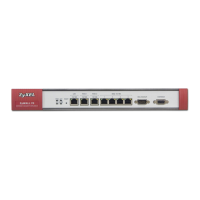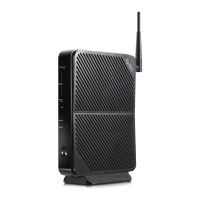Chapter 14 Intrusion Detection and Prevention (IDP) Screens
ZyWALL 5/35/70 Series User’s Guide
282
14.3.2 Intrusion Severity
Intrusions are assigned a severity level based on the following table. The intrusion severity
level then determines the default signature action.
14.3.3 Signature Actions
You can enable/disable individual signatures. You can log and/or have an alert sent when
traffic meets a signature criteria. You can also change the default action to be taken when a
packet or stream matches a signature. The following figure and table describes these actions.
Note that in addition to these actions, a log may be generated or an alert sent, if those check
boxes are selected and the signature is enabled.
Web Attack Web attack signatures refer to attacks on web servers such as IIS (Internet
Information Services).
SPAM Spam is unsolicited "junk" e-mail sent to large numbers of people to promote
products or services. Refer to the anti-spam chapter for more detailed information.
Other This category refers to signatures for attacks that do not fall into the previously
mentioned categories.
Table 78 SECURITY > IDP > Signature: Attack Types (continued)
TYPE DESCRIPTION
Table 79 SECURITY > IDP > Signature: Intrusion Severity
SEVERITY DESCRIPTION
Severe These are intrusions that try to run arbitrary code or gain system privileges.
High These are known serious vulnerabilities or intrusions that are probably not false
alarms.
Medium These are medium threats, access control intrusions or intrusions that could be false
alarms.
Low These are mild threats or intrusions that could be false alarms.
Very Low These are possible intrusions caused by traffic such as Ping, trace route, ICMP
queries etc.
Table 80 SECURITY > IDP > Signature: Actions
ACTION DESCRIPTION
No Action The intrusion is detected but no action is taken.
Drop Packet The packet is silently discarded.
Drop Session When the firewall is enabled, subsequent TCP/IP packets belonging to the
same connection are dropped. Neither sender nor receiver are sent TCP RST
packets. If the firewall is not enabled only the packet that matched the
signature is dropped.
Reset Sender When the firewall is enabled, the TCP/IP connection is silently torn down. Just
the sender is sent TCP RST packets. If the firewall is not enabled only the
packet that matched the signature is dropped.
Reset Receiver When the firewall is enabled, the TCP/IP connection is silently torn down. Just
the receiver is sent TCP RST packets. If the firewall is not enabled only the
packet that matched the signature is dropped.
Reset Both When the firewall is enabled, the TCP/IP connection is silently torn down. Both
sender and receiver are sent TCP RST packets. If the firewall is not enabled
only the packet that matched the signature is dropped.

